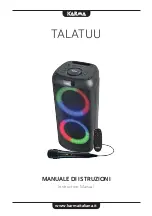
Keep the shielding gas cylinders well away from any welding or other electrical
circuits.
Never hang a welding torch on a shielding gas cylinder.
Never touch a shielding gas cylinder with an electrode.
Risk of explosion - never attempt to weld a pressurised shielding gas cylinder.
Only use shielding gas cylinders suitable for the application in hand, along with
the correct and appropriate accessories (regulator, hoses and fittings). Only use
shielding gas cylinders and accessories that are in good condition.
Turn your face to one side when opening the valve of a shielding gas cylinder.
Close the shielding gas cylinder valve if no welding is taking place.
If the shielding gas cylinder is not connected, leave the valve cap in place on the
cylinder.
The manufacturer's instructions must be observed as well as applicable national
and international regulations for shielding gas cylinders and accessories.
Danger from es-
caping shielding
gas
Risk of suffocation from the uncontrolled escape of shielding gas
Shielding gas is colourless and odourless and, in the event of a leak, can displace
the oxygen in the ambient air.
-
Ensure an adequate supply of fresh air with a ventilation rate of at least
20 m³/hour.
-
Observe safety and maintenance instructions on the shielding gas cylinder or
the main gas supply.
-
Close the shielding gas cylinder valve or main gas supply if no welding is tak-
ing place.
-
Check the shielding gas cylinder or main gas supply for uncontrolled gas
leakage before every start-up.
Safety precau-
tions in the place
of use and for
storage and
transport
A toppling device can cause life-threatening injuries. Place the device on a solid,
level surface so that it remains stable
-
The maximum permissible tilt angle is 10°.
Do not operate or store the device in a potentially explosive atmosphere.
Special regulations apply in rooms at risk of fire or explosion.
Observe relevant national and international regulations.
Use internal directives and checks to ensure that the workplace environment is
always clean and clearly laid out.
Only set up and operate the device in accordance with the degree of protection
shown on the rating plate.
When setting up the device, ensure there is an all-round clearance of 0.5 m (1 ft.
7.69 in.) to ensure that cooling air can flow in and out freely.
When transporting the device, observe the relevant national and local guidelines
and accident prevention regulations. This applies especially to guidelines regard-
ing the risks arising during transport.
After transporting the device, it must be visually inspected for damage before
commissioning. Any damage must be repaired by trained service technicians be-
fore commissioning the device.
17
EN
Содержание AccuPocket 150/400 TIG
Страница 2: ......
Страница 6: ...6...
Страница 7: ...Safety rules 7...
Страница 8: ...8...
Страница 24: ...24...
Страница 25: ...Power source 25...
Страница 26: ...26...
Страница 28: ...Application areas MMA welding TIG welding 28...
Страница 56: ...Every 2 months Clean the air filter if fitted 1 56...
Страница 69: ...Charger 69...
Страница 70: ...70...
Страница 84: ...84...
Страница 85: ...85 EN...
Страница 86: ...86...
Страница 87: ...87 EN...
















































